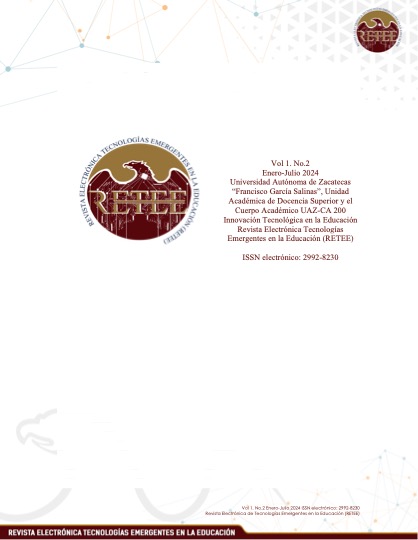Artículos de Investigación
The active STEAM methodology for the development of multiplication in algebraic problems in high school students
Published 2025-01-08 — Updated on 2025-01-28
Keywords
- Problem solving,
- STEAM methodolog,
- Multiplication algorithm,
- Algebraic thinking
Copyright (c) 2025 Miguel Ángel Gonzalez Villegas, José de Jesús Hernández Díaz

This work is licensed under a Creative Commons Attribution 4.0 International License.
How to Cite
The active STEAM methodology for the development of multiplication in algebraic problems in high school students. (2025). Revista Electrónica Tecnologías Emergentes En La Educación, 1(2), 48-62. https://doi.org/10.71713/v5m0pm48
Abstract
The purpose of this work is to deepen the study of the implications of critical thinking in solving mathematical problems. By using algorithms such as multiplication, experience is nourished to expand the recognition that students have of the practical uses of some content linked to linear and quadratic equations, that is, to measurement and calculation in different contexts. Said project described is oriented towards the transformation of teaching practice, pedagogical touch and the perspective of teaching in this type of content with the aim of integrating students in the tangible progress of their learning processes,through the development of a series of innovative strategies such as the STEAM methodology.This applied methodology serves as the basis for the formulation of this article, and in line with the policies of the New Mexican School (Secretaría de Educación Pública [SEP], 2022). Referred to as STEAM for its acronym in English Science, Technology, Engineering, the Arts and Mathematics (Science, Technology, Engineering, Arts and Mathematics).This applied research is of an inductive type and aims to analyze the observed phenomenon, from a qualitative perspective, since one of the purposes was to find answers, through scientific research, to a problem of daily school life and of the classroom, at the middle level of basic education. The research was carried out in a telesecondary school in a rural community and specifically with a group of third grade adolescents made up of eight women and six men. Among the most relevant results obtained, it stands out that in addition to improvements in learning, students also overcame some cognitive barriers and increased the level of motivation and commitment in mathematical learning and the development of algebraic thinkingDownloads
Download data is not yet available.
References
- Bosch, M. y Gascón, J. (2010). Fundamentación antropológica de las organizaciones didácticas: de los “talleres de prácticas matemáticas” a los “recorridos de estudio e investigación”. Université de Montpellier, p. 55-91
- Gómez-Ferragud, Carlos B.; Solaz-Portolés, Juan José; Sanjosé, Vicente. (2014). Dificultades para Codificar, Relacionar y Categorizar Problemas Verbales Algebraicos: dos estudios con estudiantes de secundaria y profesores en formación Boletim de Educação Matemática, vol. 28, núm. 50, diciembre
- Calculaareas (s/f), promoviendo el pensamiento crítico en matemáticas. Promoviendo el pensamiento crítico en matemáticas | Calcular Área (calcularareas.com)
- Carreón, Daniel. (2018). Graficar funciones cuadráticas. Super fácil. (52) GRAFICAR FUNCIONES CUADRÁTICAS Super facil - YouTube
- Cano de Faroh, Alida (2007). Cognición en el adolescente según Piaget y Vygotski. ¿Dos caras de la misma moneda? Boletín Academia Paulista de Psicologia [en línea]. 2007, XXVII(2), 148-166 https://www.redalyc.org/articulo.oa?id=94627214
- Chevallard, Y. (1999) L’analyse des pratiques enseignantes en théorie anthropologique du didactique. Recherches en Didactique des Mathématiques, Grenoble, La Pensée Sauvage,
- Comisión Nacional para la Mejora Continua de la Educación (2023). ¡Aprendamos en comunidad! Los ejes articuladores: pensar desde nuestra diversidad fasciculo4_aprendamos-comunidad.pdf (mejoredu.gob.mx)
- CTB (2022) ¿Qué es la metodología STEAM? ¿Qué es la metodología STEAM? | CTB
- González Mendieta, (2022). Volumen de una pirámide recta y oblicua. Volumen de una pirámide recta y oblicua (tec.ac.cr)
- Isaías Miranda, Luis Radford y José Guzmán, José. (2007). Interpretación de gráficas cartesianas sobre el movimiento desde el punto de vista de la teoría de la objetivación
- Lifeder. (s/f). Razonamiento deductivo. Razonamiento deductivo: qué es, características, tipos, ejemplos (lifeder.com)
- SEP (2022) Avance del programa sintético. Fase 6. Avance-Programa-Sintetico-Fase-6.pdf (sep.gob.mx)
- SEP. (2023). Conoce la innovadora metodología STEAM en la nueva Escuela Mexicana. Conoce la innovadora metodología STEAM en la nueva Escuela Mexicana
- SEP. (2023). Nueva escuela mexicana. Presentación de PowerPoint (sep.gob.mx)
- Sierra Delgado, Tomás Ángel; Bosch Casabó, Marianna; Gascón Pérez, Josep. (2013). El Cuestionamiento Tecnológico-Teórico en la Actividad Matemática: el caso del algoritmo de la multiplicación CTB. Redalyc.El Cuestionamiento Tecnológico-Teórico en la Actividad Matemática: el caso del algoritmo de la multiplicación
- Strathern, (1997) Pitágoras y su teorema. Pitágoras y su teorema - Paul Strathern - Google Libros
- Zapatera Linares, Alberto (2002). La generalización de patrones como herramienta para introducir el pensamiento algebraico en educación primaria.


